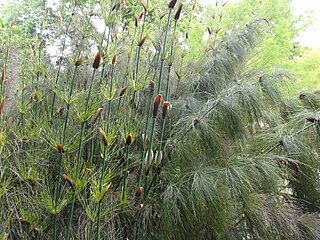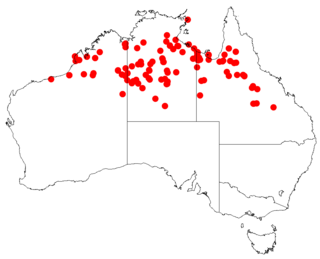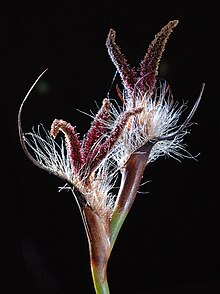
The Restionaceae, also called restiads and restios, are a family of flowering plants native to the Southern Hemisphere; they vary from a few centimeters to 3 meters in height. Following the APG IV (2016): the family now includes the former families Anarthriaceae, Centrolepidaceae and Lyginiaceae, and as such includes 51 genera with 572 known species. Based on evidence from fossil pollens, the Restionaceae likely originated more than 65 million years ago during the Late Cretaceous period, when the southern continents were still part of Gondwana.

Lycopus is a genus in the family Lamiaceae. They are all herbaceous plants native to Europe, Asia, Australia, and North America. The species are most often found in wetlands, damp meadows, and stream banks. Some of the wetland species have become endangered.
Plantago debilis is a species of herb native to Australia. Common names include shade plantain and weak plantain.
Xerochloa is a genus of Australian and Southeast Asian plants in the grass family.

Pterostylis barbata, commonly known as the western bearded greenhood or bird orchid is a species of orchid endemic to the south-west of Western Australia. Flowering plants have a rosette of leaves at the base of the plant and a single translucent white flower with dark green veins on a flowering stem with up to 20 stem leaves. It is one of a number of bearded orchids, some of which have yet to be formally described, all of which have a distinctive feather-like labellum.

Dampiera hederacea, commonly known as the karri dampiera, is an erect perennial herb in the family Goodeniaceae. The species, which is endemic to the south-west of Western Australia, is a low spreading shrub which reaches 40 cm (16 in) across. It produces blue flowers between August and January in its native range.
Hemichroa is a small genus of plants in the family Amaranthaceae containing three species. It is endemic to Australia.
Hemichroa pentandra, commonly known as trailing hemichroa, trailing saltstar or trailing jointweed, is a prostrate perennial herb in the amaranth family. It is endemic to Australia. A succulent halophyte, it grows to about 10 cm in height and 30 cm wide. It has tiny, inconspicuous white flowers, surrounded by papery bracts, which grow in the angle between the stem and the 12 mm long leaves. It is found in coastal salt marshes and around salt lakes.

Coopernookia is a plant genus of six species of small perennial shrubs that are all endemic to Australia. They have hairy, often sticky leaves, and flowers with bilateral symmetry.

Lobelia pedunculata, commonly known as matted pratia, trailing pratia or blue star creeper is a perennial herb from Australia.

Johnsonia is a genus five species of herbs in the family Asphodelaceae, all of which are endemic to the south-west of Western Australia. They are grass-like plants with minute flowers surrounded by bracts which are often tinged with white, pink or cream.
Synaphea polymorpha, commonly known as Albany synaphea, is a species of small shrub in the flowering plant family Proteaceae. It is endemic to Western Australia. The Noongar peoples know the plant as bindak.

Conospermum huegelii, commonly known as the slender smokebush, is a plant endemic to Western Australia.
Cyperus sexflorus is a sedge of the family Cyperaceae that is native to Australia.

Cyperus vaginatus, commonly known as stiff-leaf sedge or stiff flat-sedge, is a sedge of the family Cyperaceae that is native to Australia.
Eleocharis acuta, commonly known as common spikerush or small spikerush, is a sedge of the family Cyperaceae that is native to Australia.
Fimbristylis acicularis is a sedge of the family Cyperaceae that is native to northern and north eastern Australia.

Fimbristylis caespitosa, commonly known as fringe-rush, is a sedge of the family Cyperaceae that is native to northern parts of Australia.

Alternanthera denticulata is a small prostrate white-flowering herb in the Amaranthaceae family. It is native to all states and territories of Australia, New Guinea, and the North Island of New Zealand. It is also one of the food plants of the varied eggfly, Hypolimnas bolina nerina.

Tribulus occidentalis, common name perennial caltrop, is a species of flowering plant in the family Zygophyllaceae, which is native to Australia, and found in Western Australia, Queensland, South Australia and the Northern Territory.













